2013 Ford Fusion Energi Titanium vs. 2014 Honda Accord Plug-In Hybrid
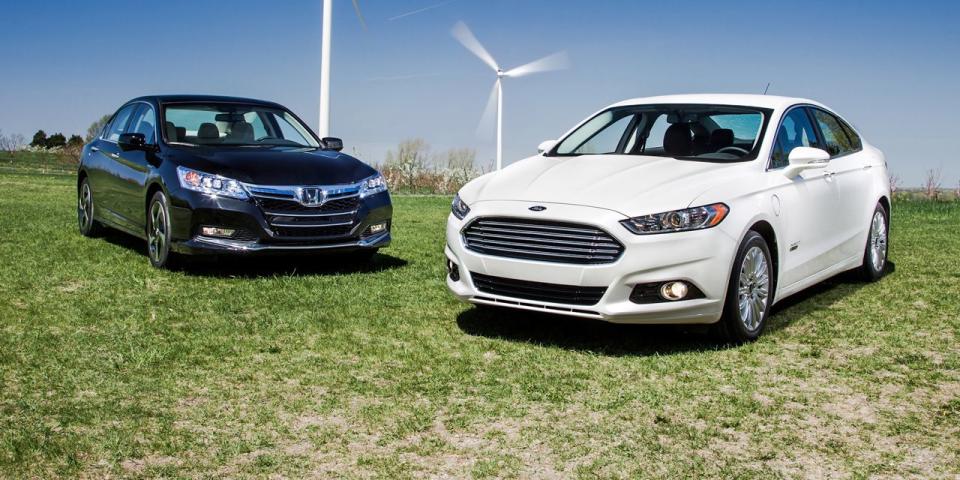
From the August 2013 Issue of Car and Driver
TESTED
If you are dubious about electrified cars entering the American fleet, consider the two subjects of this comparison test. Both of these models were newly redesigned for 2013, and, as of this writing, the Honda Accord is the bestselling nameplate in the country. The Ford Fusion is the third-best seller. But their respective companies are not putting their feet up on their desks. Both are introducing plug-in hybrid versions of their crowd-pleasers—the first such powertrains to be added to cars normally equipped with conventional engines.
The Ford Fusion Energi was quicker out of the gate, hitting the market a few months after the Fusion hybrid. Both cars, as well as Ford’s C-Max twins, share the same powertrain: a 141-hp, 2.0-liter four-cylinder Atkinson-cycle internal-combustion engine coupled to a pair of AC electric motors. A 118-hp motor propels the car while a second motor-generator works with a planetary-gear continuously variable transmission (CVT) to blend the internal-combustion and electric power as needed.
The biggest difference between the Fusion Energi and the Fusion hybrid is the size of their lithium-ion battery packs. It grows in the Energi about five-fold, from 1.4 kWh to 7.6. That’s enough to provide the Energi with an electric-only range of 21 miles, according to the Environmental Protection Agency, while achieving 100 MPGe (or miles per gallon of gasoline equivalent, the EPA’s convoluted method of placing an mpg rating on electric vehicles). Thanks, however, to the nearly 300-pound weight increase that accompanies the bigger battery, the fuel consumption when operating on gasoline falls from the hybrid’s 47-mpg EPA rating to 43.
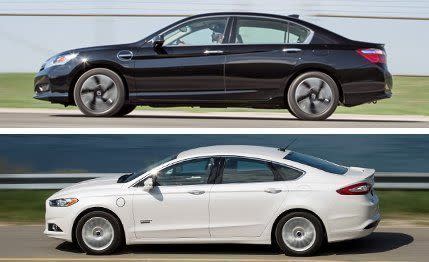
Honda didn’t invent a fancy name for its new model, calling it simply the Accord Plug-In, though the badges on the car say “hybrid.” We’ll see what the company does when the non-plug-in Accord hybrid arrives in the fall. In any case, this Honda uses a new hybrid system unlike any we've seen before. The 2.0-liter Atkinson-cycle four-cylinder develops the same 141 horsepower as the Fusion's engine. Honda uses two electric motors, like the Fusion; but here one drives the wheels, the other serves mainly as a generator. The Accord’s traction motor develops 166 horsepower—48 more than the Ford’s, though the combined output is up only eight horsepower on the Fusion to an estimated 196. While the Accord Plug-In hybrid is the first application of Honda’s new two-motor system, it will also appear in an Accord hybrid equipped with a smaller-capacity lithium-ion battery.
Honda has fitted a slightly smaller battery than has Ford, rated at 6.7 kWh, and this produces roughly a third less rated electric range—only 13 miles. But just as the conventional Accord is about 200 pounds lighter than the equivalent Fusion, so is the PHEV version. That results in 115-MPGe and 46-mpg EPA-combined ratings, both of which beat the Fusion’s numbers.
Technology costs money, so the base price of each car lands around $40,000, or about 10 grand dearer than similarly equipped, conventionally powered equivalents. This lofty pricing puts these two plug-ins up against the Chevy Volt. Yes, the Volt is smaller than these mid-size sedans, but you’re only going to notice that from the rear seat. On the other hand, the Volt has more trunk space than either the Fusion or the Accord and greater electric range. In contrast to the Ford and Honda plug-ins, the Volt is electrically driven all of the time. And thanks to a federal tax credit that’s keyed to battery capacity, the Volt can actually be less expensive. When you drive either of the cars in this test, though, you won’t be behind the wheel of so obvious a political punching bag.
The Accord Plug-In is based on the ninth-generation model that vanquished all family-sedan comers in our comparison test last November but lost to the sportier new Mazda 6 a few months back. It’s an excellent car, and most of that goodness flows directly into the plug-in version.
The Plug-In weighs about 400 pounds more than a loaded Accord EX-L, an increase minimized by the use of aluminum in the Plug-In’s front subframe, hood, rear-bumper structure, and brake pedal. This edition also has a little more combined power and torque, though Honda is coy about the exact figures.
The result is similar acceleration to the Accord EX-L’s, at least at low speed, with zero to 60 coming up in 7.7 seconds. By 100 mph, however, the Plug-In is nearly three seconds in arrears. The Plug-In nevertheless moves off smartly from rest and generally feels peppy.
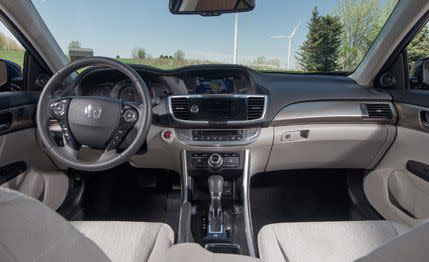
It’s slower in electric-only mode, but we couldn’t document the deficit because the engine wakes up when you accelerate too aggressively. That said, you can run to 70 mph in EV mode as long as the road is fairly flat and you feather-foot the throttle.
Starting off with a full battery, we managed to drive 14 miles before the engine fired up. You can also lock the car in the hybrid vehicle or “HV” mode to save your battery charge until later in your trip. An “HV Charge” mode uses the engine to charge the battery while you’re driving—at the cost of some fuel consumption, of course.
On our 500-mile test drive, the Accord averaged 42 mpg, including the electric-only portion. About half the trip was on Michigan back roads, where we averaged 50 mph and the Accord squeezed 45 miles from each gallon. On the 75-mph freeway half of our trip, it still delivered 40 mpg. That’s excellent efficiency for a comfortable, roomy sedan.
Though it promises to save even more fuel, you should avoid the Accord’s eco button if you have even one enthusiastic bone in your body. It renders the car unresponsive and makes the already indolent cruise control seem even lazier.
We didn’t care for the electrically assisted power steering, either. Though it feels fine on the standard Accord, it’s overboosted here, making turn-in feel a bit twitchy. Also, the Accord Plug-In doesn’t track as well as the Fusion. Its suspension feels softer, too, with less body control than the Fusion’s. This pays off with a placid ride on smooth roads, but it also produces a certain disconnected feeling when you start hurrying.
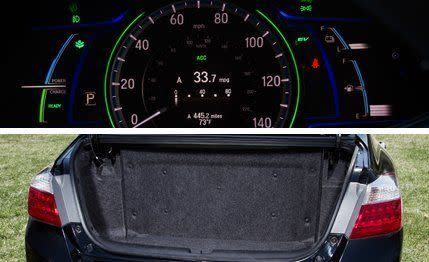
On the other hand, the Accord’s electric booster blends regenerative braking with the friction brakes more smoothly than the Fusion’s setup does. There’s also a “B” mode in the transmission that increases regenerative braking when you lift off the accelerator. This allows you to safely drive using only the right pedal at moderate speeds, as in a Tesla.
Otherwise, the Plug-In is the same superior and practical sedan as any other Accord. The cabin is roomy, and while you lose nearly half of the standard car’s trunk space, you’re left with a usable shape.
The Plug-In wears some odd blue-tinted trim, and its forged-aluminum wheels are shrouded by tacky aerodynamic hubcaps. Inside, the “Bio-Fabric” upholstery looks cheap. And do we really need a “hybrid” badge on the charge port cover?
Still, if you like the current Accord and are intrigued by the idea of running some of your miles on electricity, this Plug-In will do nicely.
The current Fusion’s European road manners mostly carry over to the Energi. The suspension controls body motions well, and you are always aware of what’s taking place between your tires and the pavement. The Fusion steers with deft precision and feedback.
Unfortunately, some of this dynamic superiority is offset by the quarter-ton that the Energi gains over the Fusion SE we compared last year. The extra mass conspires with the low-rolling-resistance tires to deliver only 0.80 g of skidpad grip and a lengthy, 185-foot stop from 70 mph. Both figures are worse than a standard Fusion’s performance and slightly behind the lighter Accord Plug-In’s. But we prefer the Fusion over the Accord in brisk, real-world driving.
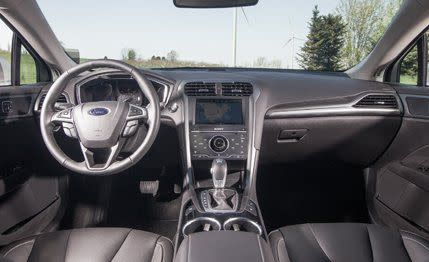
The Energi’s extra weight also sapped its acceleration. It took 8.6 seconds to hit 60 mph, almost a second slower than the Accord Plug-In, though the gap narrowed at higher speeds. When you lock the Energi into EV mode, your available power drops from 188 to 118, stretching your zero-to-60 time to 14.6 seconds. However, you can drive up to 85 mph on electrons alone as long as you’re patient getting there.
Driven at a sedate pace, the Fusion went 19 miles on electric power, more than a third farther than the Accord. That’s mostly because the Fusion consumes a lot more of the electricity in its slightly larger battery. By the numbers, the Fusion uses 50 percent more electricity per mile than the Accord, but it only costs 5 cents per mile to run the car on electricity (at 12 cents per kWh) versus about 10 cents per mile on gasoline. Generally, the Fusion’s longer electric range makes it cheaper to run. Honda’s advantage lies in its shorter recharging times, thanks to a more efficient charger and lower electricity consumption. In its gasoline-powered hybrid mode, the Fusion gets about 1 mpg less than the Accord, a negligible difference at 40 mpg.
Striking styling is one of the Fusion’s strong points, and, unlike the Accord Plug-In, the Energi is as attractive as any other Fusion. It also boasts nice details, such as available leather upholstery and soft plastic on the sides of the consoles where your lower legs are likely to make contact.
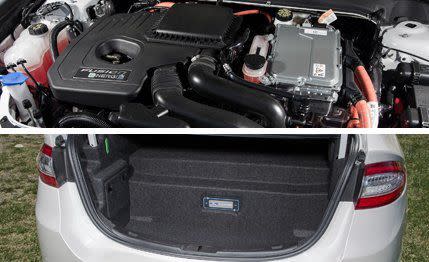
We also prefer the Fusion’s infotainment system. Both it and the Accord’s require master’s degrees in their operation, but MyFord Touch allows you, for example, to input a complete address—including the house number, street, and city—in a single voice command. The Accord’s system breaks that up into about a dozen steps and still gets it wrong more often than the Ford’s does.
In the end, there’s no clean division of merits here. The Accord is quicker, but the Fusion drives more assuredly. The Honda uses less energy, but the Ford has a greater electric range. In the end, we picked the Fusion because it’s better looking, the more capable plug-in, and, ultimately, the more enjoyable car to drive. The Fusion Energi proves that, in the search for efficiency through electrons, it’s still possible to find driver satisfaction. Of course, neither car makes financial sense, but we suspect that the major purchase motivation here is a different shade of green.
Vehicle2013 Ford Fusion Energi Titanium 2014 Honda Accord Plug-In Hybrid Base Price$40,895$40,570Price as Tested$42,285$40,570DimensionsLength191.8 inches193.5 inchesWidth72.9 inches72.8 inchesHeight58.0 inches57.7 inchesWheelbase112.2 inches109.3 inchesFront Track62.3 inches62.4 inchesRear Track62.0 inches62.7 inchesInterior VolumeF: 58 cubic feet
R: 48 cubic feetF: 56 cubic feet
R: 47 cubic feetTrunk8 cubic feet9 cubic feet
PowertrainEngineDOHC 16-valve Atkinson-cycle inline-4
122 cu in (1999 cc)DOHC 16-valve Atkinson-cycle inline-4
122 cu in (1997 cc)Power HP @ RPM141 @ 6000141 @ 6200Torque LB-FT @ RPM129 @ 4000122 @ 2500MotorAC permanent-magnet synchronous AC permanent-magnet synchronous Power HP @ RPM118 @ 6000166 @ 8000Torque lb-ft117226Battery Chemistrylithium-ionlithium-ionBattey Capacity7.6 kWh6.7 kWhCombined HP188196 (est)LB Per HP21.219.3 (est)DrivelineTransmissionCVT1-speed direct driveDriven WheelsfrontfrontAxle Ratio:12.913.42
ChassisSuspensionF: struts, coil springs, anti-roll bar
R: multilink, coil springs, anti-roll barF: struts, coil springs, anti-roll bar
R: multilink, coil springs, anti-roll barBrakesF: 10.9-inch vented disc
R: 11.0-inch discF: 11.5-inch vented disc
R: 11.1-inch discStability Controlpartially defeatablepartially defeatableTiresMichelin Energy Saver A/S
P225/50R-17 93V M+SMichelin Energy Saver A/S
P225/50R-17 94V M+S
C/D Test
ResultsAcceleration0–30 MPH3.1 sec3.1 sec0–60 MPH8.6 sec7.7 sec0–100 MPH23.0 sec22.1 sec¼-Mile @ MPH16.6 sec @ 8616.1 sec @ 88Rolling Start, 5–60 MPH9.3 sec7.9 secTop Gear, 30–50 MPH4.6 sec3.8 secTop Gear, 50–70 MPH6.0 sec5.8 secTop Speed104 mph (gov ltd)114 mph (gov ltd)ChassisBraking 70–0 MPH185 feet184 feetRoadholding,
300-ft-dia Skidpad0.80 g*0.82 g*610-ft slalom38.4 mph*40.1 mph*WeightCurb3986 pounds3783 pounds%Front/%Rear54.2/45.855.8/44.2CG height23.0 inches22.0 inchesFuelTank14.0 gallons12.2 gallonsRating87 octane87 octaneepa electricity+gasoline combined100 MPGe115 MPGeEPA City/Hwy44/41 mpg47/46 mpgC/D 500-Mile Trip41 MPGe42 MPGeSound LevelIdle32 dBA30 dBAFull Throttle75 dBA72 dBA70-MPH Cruise68 dBA69 dBA* stability-control-inhibited
tested in Chelsea, Michigan, by K.C. Colwell
Final ResultsVehicleMax Pts. Available2013 Ford Fusion Energi Titanium2014 Honda Accord Plug-In HybridDriver Comfort1078Ergonomics1086Rear-seat Comfort545Rear-seat Space*555Trunk Space*555Features/Amenities*10107Fit and Finish1089Interior Styling1088Exterior Styling1097Rebates/Extras*522As-tested Price*201920Subtotal1008582
Powertrain1/4-mile Acceleration*201820Flexibility*535Fuel Economy*10910Engine NVH1077Transmission1077Subtotal554449
ChassisPerformance*201920Steering Feel1086Brake Feel1067Handling1087Ride1088Subtotal604948
ExperienceFun to Drive251411
Grand Total240192190

You Might Also Like

 Yahoo Autos
Yahoo Autos 